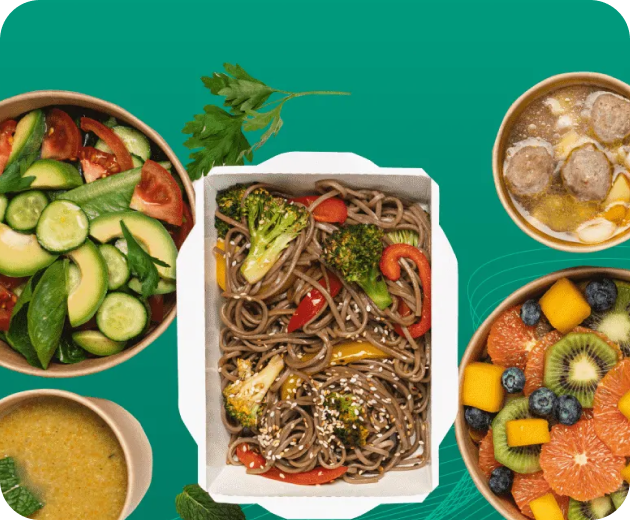Top 5 Away-from-home Consumer Trends in the Food Industry
Consumer trends in the food industry are constantly evolving, especially in the away-from-home sector. This article delves into the five leading consumer trends in the “away from home” sector that are currently defining the food industry.
We’ll provide insights on how food businesses can leverage these trends for innovation, and growth, and to meet their customers’ changing needs.
Are Consumer Trends in the Food Industry Different for Away-From-Home Businesses?
Yes, they are! Consumer trends in the food industry vary greatly between away-from-home businesses and traditional restaurants. Away-from-home businesses include food trucks, convenience stores, coffee shops, and other establishments that provide meals or snacks outside of the home.
Unlike traditional restaurants where customers typically sit down to enjoy a full meal, away-from-home businesses cater to customers who are often on the go and looking for quick and convenient meals. This fundamental difference in consumer behavior greatly impacts the trends shaping the away-from-home food industry.
Trend #1: Convenience and on-the-go Packaging
In today’s fast-paced world, consumers are seeking meal options on the go. As a result, convenience has become a top priority, driving demand for innovative packaging and easy portable meal solutions. Food businesses should consider the following aspects to cater to this trend:
On-the-go meals: Offer quick and convenient meal options, such as pre-packaged salads, sandwiches, or ready-to-eat bowls to enjoy on the move.
Digital ordering options: Utilize food delivery apps and online ordering systems to provide customers with a seamless and convenient food ordering and delivery experience.
Personalization: Enable consumers to customize their meals to suit their preferences and dietary needs through build-your-own options or meal modifications.
Trend #2: Healthy and Nutritious Options
Today’s consumers are increasingly conscious of their health and well-being, influencing their decision-making when dining away from home. Food businesses should incorporate the following considerations when catering to this health-conscious mindset:
Fresh ingredients and organic options: Source high-quality, fresh ingredients, prioritize organic produce, and design menus featuring balanced and nutritious meals.
Plant-based and vegan foods: Accommodate the rising popularity of plant-based diets by incorporating vegan or vegetarian options and offering plant-based alternatives to traditional meat and dairy products.
Meal replacements and nutritional snacks
The way people consume food is shifting, with many opting for smaller, snack-like options rather than traditional full meals. Food businesses can adapt to this trend by:
Offering smaller bites: Focus on crafting menu trends that feature a variety of small bites, sharing plates, and tapas-style options for consumers to enjoy.
Providing nutrient-dense snacks: Develop snack options that are both healthy and satisfying by incorporating nutrient-dense ingredients that cater to consumers looking for meal replacements.
Trend #3: Global Cuisine and Flavor Exploration
Curiosity for global flavors and unique culinary experiences has inspired the following trends in dining away from home:
Ethnic and global cuisine: Embrace cultural diversity by offering a wide range of ethnic cuisines that allow consumers to explore new flavors and enjoy unique dining experiences.
Street food and food trucks: Capitalize on the growing popularity of street food and food trucks by offering diverse culinary options, exciting flavor combinations, and casual dining experiences.
Fusion dishes: Experiment with fusion cuisine by combining different cultural flavors and techniques to create unique and memorable menu items. This trend allows for endless creativity and the opportunity to stand out in a crowded food industry.
Authenticity: As global cuisines become more popular, consumers are also seeking authenticity in their dining experiences. Incorporate traditional cooking methods, ingredients, and flavors to truly capture the essence of a particular cuisine.
Trend #4: Sustainability and Eco-Friendly Practices
As consumers become more environmentally conscious, they are also seeking out food businesses that prioritize sustainability and eco-friendly practices. Some ways food businesses can adapt to this trend include:
Locally sourced ingredients: Source ingredients from local farms and suppliers to reduce carbon footprint and support the local community. This also allows for fresher and more seasonal menu offerings.
Sustainable packaging: Switch to eco-friendly packaging options, such as biodegradable or compostable materials, to reduce plastic waste.
Waste reduction: Implement strategies to reduce food waste, such as composting or donating excess food to charities. Utilize sustainable practices in kitchen operations, such as energy-efficient equipment and water conservation methods.
Trend #5: Inclusivity and Diversity
With increased awareness and advocacy for inclusivity and diversity, food businesses have the opportunity to embrace this trend by:
Inclusive menus: Offer menu options that cater to different dietary restrictions, such as gluten-free, vegan, or halal. This allows for a wider customer base and ensures that all diners feel welcome.
Representation: Showcase diversity in marketing materials, such as menu photos or social media posts, to reflect the inclusivity of your business.
Community involvement: Partner with local organizations or charities that promote inclusivity and diversity. This not only shows support for important causes but also allows for networking opportunities and potential collaborations.
FAQs
Key trends include plant-based eating, functional foods, global flavors, and convenience-driven formats. Digital engagement and sustainability are also shaping purchasing behavior.
They guide ingredient selection, flavor profiles, and packaging claims. R&D teams use trend data to create offerings that meet emerging needs and stand out in a crowded market.
Trends predict where demand is heading. By tracking them, brands stay ahead, innovate with purpose, and avoid misaligned product launches.
Conclusion
Understanding and adapting to the top five away-from-home consumer trends is essential for food businesses to thrive in today’s competitive landscape. By focusing on convenience and on-the-go packaging, offering healthy and nutritious options, providing meal replacements and nutritional snacks, and embracing global cuisine and flavor exploration, food businesses can deliver exceptional customer experiences and remain relevant in an ever-evolving industry.
To capitalize on these trends, consider evaluating your current offerings and identifying areas of improvement while staying informed about emerging trends and shifting consumer preferences to maintain a competitive edge and meet the ever-changing demands of today’s food enthusiasts.
If you want to learn more about Tastewise’s food and beverage intelligence software, browse our website today!




